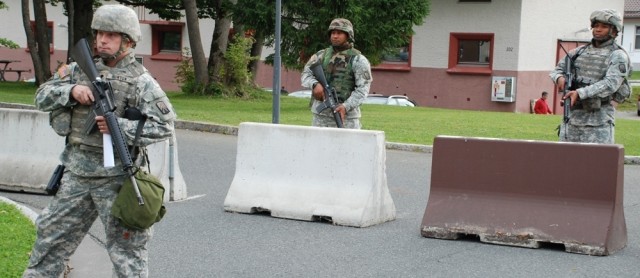
WASHINGTON (Army News Service, July 24, 2009) -- The Army has developed Phase II of its Antiterrorism Strategic Plan, called "Tempering the Weapon."
The plan, developed by the Antiterrorism Branch under the Provost Marshal General's Office, serves as guidance on anti-terrorism for the entire Army community. The plan contains goals and objectives that guide improvement in protection and contains measures of success so these goals and objectives can be reviewed and revised as required.
The plan can be found and downloaded from Army Knowledge Online by searching for the "Antiterrorism Enterprise Portal," or ATEP.
"By following the guidelines outlined in this new plan, we can build in protection from terrorist attacks just as we defend against any enemy," said Alex Mascelli, the Army's anti-terrorism chief. "The Army calls it anti-terrorism awareness and shows that we are neither incapable of preventing a terrorist attack nor restricted from doing so since we possess the means of our own protection," Mascelli said. "Inevitability is not a given."
For example, a prospective terrorist attack at Fort Dix, N.J.in 2007 involving six men, later referred to as the "Fort Dix Six," conspired to attack and kill Soldiers on the post. They selected Fort Dix from other installations in the area mostly based upon reconnaissance and accessibility.
The group recorded their preparations and sent the video to an electronics store for duplication. An alert store employee notified the FBI who then tracked and arrested the group before they could execute their plan. The members of the group were convicted and sent to prison -- all because of an alert and aware citizen.
"The Army community represents the most formidable obstacle to terrorism," Mascelli said. "We know from studying past actions that terrorist's success depends upon a careful reconnaissance before execution.
"In some cases we know they have visited a site many times before they decided to attack. "They offer clues in their actions. "By developing a sense of those characteristics and we can prevent potential attacks," Mascelli continued.
Army policy mandates that all Soldiers and Department of the Army civilians take a Web-based course that teaches effective actions to reduce profiles. This course is called Level I Antiterrorism Training and can be found on the AKO portal (see ATEP above).
The course is also mandatory for family members going overseas and certainly available for families in the United States as well. It offers details of personal protection and is the first fundamental in preventing terrorist attacks.
Ron Francis, a noted Army anti-terrorism expert, gives some pointers: "It's not a single characteristic of a potential terrorist that can make you suspicious," says Francis.
Francis tells all to look around as they go about daily business and gradually recognize the standard ways people act. He advises to "Look for the difference." Francis refers to that as the "Where's Waldo'" effect where Waldo can be picked out from among the many people and actions going on in a picture. He emphasizes that the same can be true for where terrorism is concerned.
"We are also in the process of developing a unique and comprehensive Commander's Tool Kit," Mascelli said. "The kit will contain everything commanders at all levels need to build an antiterrorism program at their organizations."
The tool kit will debut in September in conjunction with National Preparedness Month.
"It's an opportunity for us in the antiterrorism business to partner with other Army and DOD initiatives in protecting our Soldiers and the families," said Mascelli. "Together we can make a difference."
"The enemy is often smart," said Mascelli. "They adapt quite easily, strike without warning, and then blend back into the background -- but they do have vulnerabilities.
"We must maintain our awareness, report suspicious activity and not drop our guard," Mascelli continued. "That's why the Vice Chief of Staff Gen. Peter Chiarelli took the time to make a new video designed to increase awareness of potential terrorist threats and activities."
In the video Chiarelli uses past terrorist acts to try and ensure that Army personnel maintain vigilance to protect and prevent terrorist activities.
"Terrorism is a global threat and we must all remain vigilant to the fact that terrorism can happen at any time," Chiarelli said.
The video can be viewed at https://www.us.army.mil/suite/page/605757. (AKO login required)

Social Sharing